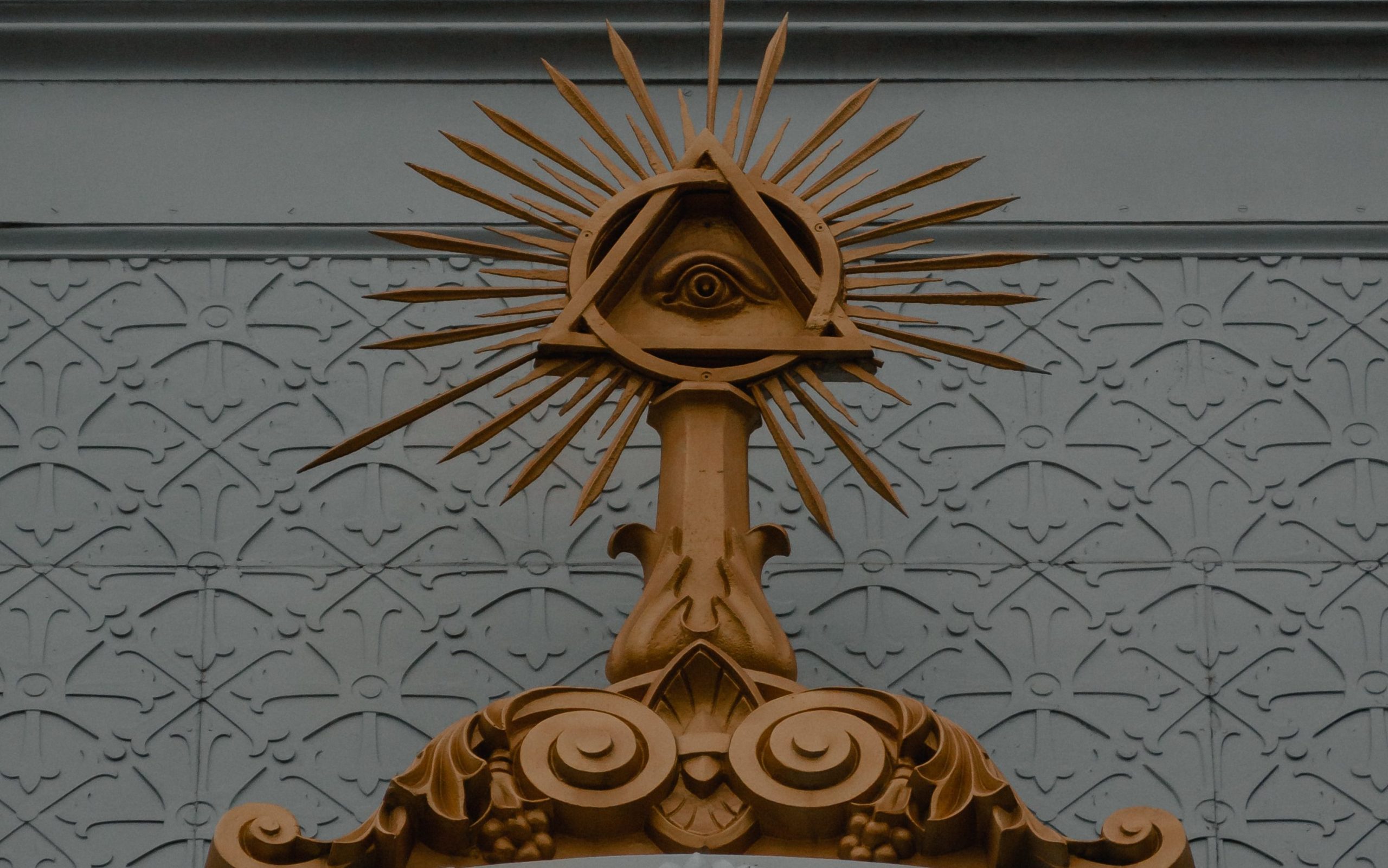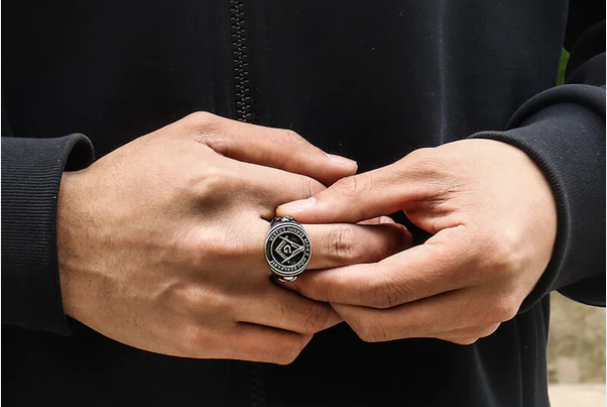Freemasonry, as the world’s oldest fraternal organization, boasts a global membership of approximately 6 million dedicated individuals. While the Freemasons are known for their guarded secrets, they also display their membership through a variety of symbols and emblems. From bumper stickers to hats, cufflinks, clothes, and, notably, masonic rings, these items serve as visible markers of their affiliation.
Among these distinct items, the masonic ring holds a paramount and timeless significance within the realm of Freemasonry. For those who proudly wear and behold them, masonic rings hold a deep well of significance that enriches the experience of ownership.
The History of Masonic Rings
Mason rings, often intriguing in their design and rich in symbolism, are emblematic of a deeply rooted history dating back to the Middle Ages. These rings are, in essence, signet rings, proclaiming one’s allegiance to the Masonic fraternity.

The roots of the masonic ring can reach far into the Middle Ages. At that time, it was popular to seal the documents in wax to authenticate their legitimacy. In these bygone days, the privilege of wearing a freemasonry ring was reserved for royalty, nobility, and dignitaries. These rings were crafted from precious metal, and adorned with enamels, gems, and intricate craftsmanship. It was a symbol of distinction and honor.
As time flowed on, the wearers grew to encompass not just the elite but also merchants and tradesmen. Young Freemasons of today embrace the tradition by wearing signet rings in their everyday attire or on formal occasions.
Famous Maon Ring Wearer

The wearers have left an indelible mark on history, with notable figures such as George Washington. He is the revered first President of the United States and a prominent Freemason. The allure of these rings transcends time and geography. The renowned philosopher and writer Voltaire, also wore a masonic ring, reflecting the enduring connection between Masonic ideals and enlightenment.
While the tradition of signet rings dates back to ancient times, with notable wearers including figures like Caesar, Nero, Cicero, and even the illustrious Michelangelo, it remains uncertain whether Masonry, as we know it today, has direct historical links to these ancient civilizations. Nonetheless, the enduring legacy of masonic rings continues to be intertwined with those who shaped the course of history.
Meaning of the Freemasonry ring
The masonic ring represents a wealth of meaning, bridging the gap between ancient traditions and modern interpretations. One of its fundamental meanings lies in its circular shape, which embodies the concept of the “eternity of the circle.” This symbolism extends back to early human history, reflecting the unbroken connection of a Mason to the Freemason fraternity.
Additionally, the freemason ring symbolizes the member’s unwavering loyalty and dedication to the fraternity, representing their authentic “cable tow.” However, the significance of a Freemason’s ring is not set in stone. It can vary from one member to another, influenced by individual interpretation and the diverse Masonic symbols that adorn it.
Ancient & Morden Meaning

In ancient times, these rings served as powerful symbols of loyalty, fraternity, and mutual respect among Freemasons. The ring was a marker of Mason’s unwavering allegiance to the craft, while also signifying their special status among fellow Freemasons. They were emblematic of the deep bond and the carefully guarded secrets shared among members.
In modernity, these ancient values endure, but the meaning of mason ring has expanded. They now encompass notions of personal growth, the relentless pursuit of knowledge, and a quest for enlightenment. Today, Masons often wear a ring to honor their family’s Masonic heritage, to express their dedication to their faith, or simply as a badge of pride in being part of a tradition steeped in history.
The Meanings of the Different Symbols of the Masonic Ring
Masonic rings, as adorned with a plethora of symbols and elements, are not merely jewelry but intricate embodiments of a rich history and deeper meaning. Among these symbols, the Square and Compass stand as one of the most fundamental and recognizable in Freemasonry. This iconic symbol comprises three elements: the square, the compasses, and the letter “G“.

The square, as a builder’s tool with a 90-degree angle, signifies structural integrity, mirroring the moral principle of being “square” in one’s actions, signifying honesty and fairness. In contrast, the compass, used for drawing precise circles and arcs, symbolizes self-restraint and the need for a balanced life, echoing the importance of moderation in one’s journey. The letter “G” in the Square and Compass might refer to geometry, highlighting its role in the moral lessons and the history of Mason, or it could represent a deeper spiritual connection, pointing to the “Great Architect of the Universe.”
The symbols don’t stop at the Square and Compass. Masonic rings often feature additional symbols like the all-seeing eye, acacia tree, and other Masonic emblems. They come together to enrich the significance of masonic rings and have profound meaning for those who wear them.
Different Types of the Freemason Ring
Masonic rings, diverse in design, cater to the various branches within the fraternity, making them distinctive symbols of affiliation and achievement within the Masonic order.
Blue Lodge Rings
The Blue Lodge rings, adorned with its iconic blue enamel background and gold symbols, is a steadfast representation of the fundamental degrees in Freemasonry. Its design embodies fraternity, morality, and charity. Blue stones often grace the fingers of Blue Lodge members, signifying their commitment to the foundational degrees.
Knights Templar Rings
The Knights Templar ring pays homage to the historical Knights Templar order, a chivalric organization deeply intertwined. With their iconic insignia prominently displayed, this ring embodies courage, honor, and the pursuit of endless learning, reflecting the valor and virtue that the Knights Templar represented.
Scottish Rite rings
The Scottish Rite rings serve as a symbol of mastery and enlightenment. Its intricate design encapsulates the very essence of the Scottish Rite branch, signifying the journey of self-discovery and spiritual growth. As the wearer proudly displays these rings, they declare their commitment to seeking profound knowledge and personal enlightenment.
Council Rings
Councils play a pivotal role in administration and ritual. Council rings often feature symbols specifically tailored to their functions within the Masonic structure. These rings denote a member’s engagement in the administrative aspects of the fraternity, distinguishing their role and responsibilities.
Royal Arch Chapter Rings
Chapters, as integral components of Royal Arch Masonry, have their own distinct ring, featuring symbols like the triple tau. These symbols serve as a testament to the wearer’s participation in the Royal Arch Chapter and the valuable role they play in preserving Masonic traditions and teachings.
Shriner Rings
Shriners, renowned for their philanthropic endeavors, are easily recognized by their distinctive red fez hats. A Shriner masonic ring may incorporate the fez or other symbols associated with this charitable branch of Freemasonry. Wearing these rings not only represents a commitment to charity but also a dedication to the principles of fraternity and goodwill.
Besides these main 6 types, there are also master mason rings, past master rings, and other types. You can choose your favorite and wear it to represent your identity and show your style.
How to Wear a Masonic Ring

How to wear is a matter of personal choice, and it reflects your connection to the Masonic principles and your commitment to the fraternity. Most Freemasons will choose to wear freemason rings on their pinky rings. Some will wear the ring on the third finger of the right hand, representing their dedication to the values and traditions of fraternity. This placement has a symbolic significance, serving as a conversation starter among fellow Masons and sparking discussions about your faith.
While there is no universal standard for how to wear a masonic ring, some Masons have their own preferences based on tradition and symbolism. For instance, some believe that a ring featuring the square and compasses should be worn with the points facing toward your heart, serving as a daily reminder of your Masonic obligations. Conversely, a Master Mason or Past Master may choose to turn the ring outward, displaying the points toward the world to signify their mastery of Masonic knowledge.
Regardless of how you choose to wear your masonic ring, it should be done with pride and reverence for the fraternity’s ancient traditions, ultimately serving as a symbol of your commitment and affiliation.
Conclusion
Wearing a masonic ring is a personal choice, and it carries a unique meaning for each individual. From its ancient roots to its modern interpretations, the masonic ring serves as a powerful emblem of fraternity and shared principles. Whether it’s a way to honor one’s Masonic heritage, express dedication to the craft, or simply showcase pride in being part of this esteemed tradition, a masonic ring is a cherished symbol of your fraternity.
In conclusion, owning a masonic ring is an opportunity to embrace history, wisdom, and tradition in a tangible form. The history, meaning, and symbolism of these rings continue to inspire, inviting wearers and admirers to connect with a rich and enduring legacy.
Georgia
Georgia is passionate about the realms of fashion, jewelry, and lifestyle.Her love for these topics has shaped her writing career. She is committed to creating engaging and informative content that resonates with readers from all walks of life. Together, embark on an inspiring adventure!
Recent Posts
Your Goth Christmas Style Guide
11/25/2025Cybergoth Aesthetic
11/11/2025How to Prepare for Halloween Night
10/28/2025Categories
Related Articles
Moss & Misdemeanor: Fairy Grunge Style and Outfits
The fashion world constantly mixes ideas to create new, unique looks. The...
ByAlicia11/18/2025Cybergoth Aesthetic
The alternative landscape is constantly evolving, but few aesthetics hit as hard...
ByAlicia11/11/2025How to Prepare for the Coming Halloween
The air is getting cooler, and the leaves are changing color. This...
ByAlicia09/24/2025Your Ultimate Guide to Goth Back-to-School Style
The end of summer is near, and the first day of school...
ByAlicia08/26/2025














Leave a comment